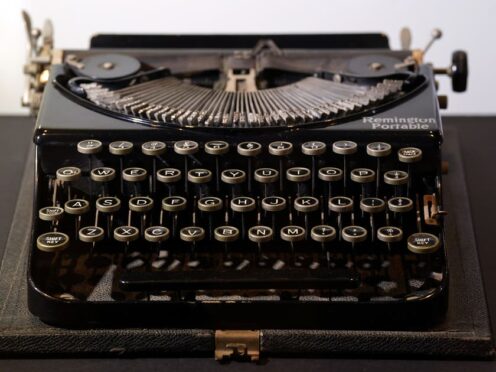Agatha Christie’s typewriter and Dictaphone are to go on display as part of a crime fiction exhibition at Cambridge University Library.
The typescript to her final Poirot Novel, Curtain, that was so top secret it was kept in a bank vault for three decades until its eventual publication will also go on show during Murder By The Book.
Curtain was published in 1975, the year before Christie’s death.

The author’s 1937 Remington typewriter, her Dictaphone and the typescript of Curtain are on loan from the Christie Archive Trust.
Also on loan from the trust for the exhibition are her draft notebooks from the writing of Curtain and Witness For The Prosecution.
The exhibition, which celebrates 20th Century British crime fiction, will feature nearly 100 of the most famous, influential and best-selling crime novels in UK history, as well as other consequential works that are now long out of print.
The majority of the novels on display are drawn from Cambridge University Library’s unique, world-class Tower collection of first editions in their original dust jackets.
Elsewhere, the exhibition also features novelist Wilkie Collins’ writing desk, as well as the library’s first edition copy of his seminal work The Moonstone.
Award-winning crime author Nicola Upson, curator of the exhibition, said: “This exhibition is a glorious selection of the novels that have influenced the genre and made household names of Sherlock Holmes, Miss Marple, Jane Tennison and Inspector Morse.

“We look at the brilliant ideas, atmospheric settings, vivid characters, the dark and dangerous themes – and those perfect, unguessable endings.
“Within each section, Golden Age classics sit alongside books by contemporary authors, revealing what these stories have in common and how much the genre has evolved.
“If you love crime podcasts or programmes, you’re going to love this exhibition!

“There are books in the exhibition which have pioneered the genre; you’ll meet the detectives that we’ve grown to know and love via extraordinary novels and TV adaptations; and you’ll also see the first use of things like forensics in crime fiction, which perhaps started much earlier than you might think.”
First editions going on display range from the earliest British crime fiction of Sir Arthur Conan Doyle, Charles Felix and Wilkie Collins – to some of the 20th and 21st century’s most recognisable authors.
A second part to the exhibition, located along the gallery corridors of Giles Gilbert Scott’s 1934 University Library building, explores crime novels set in Cambridge and works of fiction that inspired film adaptations by Alfred Hitchcock.
Murder By The Book: A Celebration of 20th Century Crime Fiction is a free exhibition which opens to the public at Cambridge University Library on Saturday, March 23.
It will run until August 24 and organisers say booking is essential.
